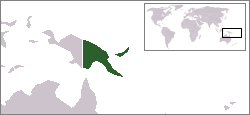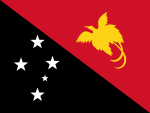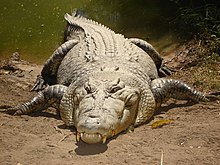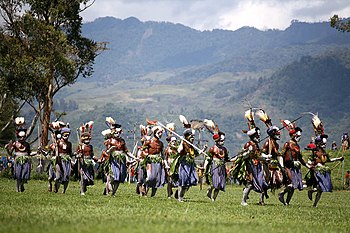| location | |
 | |
| flag | |
 | |
| Short dates | |
| Capital | Port Moresby |
|---|---|
| Form of government | Parliamentary monarchy in the Commonwealth |
| currency | 1 kina (K) = 100 toea |
| surface | 462,840 km² |
| population | 5.42 million |
| languages | Pidgin, Papuan languages, English |
| Religions | Catholics 22%, Lutherans 16%, others |
| power grid | 240 V |
| Phone code | 675 |
| Internet TLD | .pg |
| Time zone | CET 9 h |
Papua New Guinea (PNG) is in Oceania. The state consists of the eastern half of the island of New Guinea and several islands. Bordering countries are Indonesia (Western New Guinea), the Solomon Islands and in the south Australia, with which a land bridge existed during the last ice age until 8000 years ago.
Regions
| Map of Papua New Guinea highlighted: Bismarck Archipelago |
structure
The national territory of Papua New Guinea is divided into around 20 provinces. About 85% of this is in the eastern half of the island of New Guinea (in Malay: Papua). Some of the provinces are mountain provinces in the interior of the island, the coastal provinces border on the south Coral Sea, in the east is the Solomon Lake, on the north coast is the Bismarcksee.
The island world of Bismarck Archipelago consists of around 200 islands with a total of almost 50,000 km² of land. The largest island is New Britainwhich is about 520 kilometers long but less than thirty kilometers wide. The largest city was Rabaul until it was almost completely destroyed by a volcanic eruption in 1994. The main town is today Kokopo.
The 8650 km² area is also elongated New Ireland, it is northeast of New Britain.
No 14,000 people live on the eight Vitu Islands. Twelve small islands form the group of the Duke of York Islands. The northernmost part of the archipelago, just below the equator, is formed by the islands, which were almost untouched until the 1920s Manus.
The autonomous region Bougainville lies in the east of the state and was called until 2005 North Solomons Province. The local residents waged a guerrilla war from 1989 to 1997 against the economic interests of the mining companies active here. In an independence referendum held in 2019, the residents spoke out in favor of independence.
Kiriwina
At the southeast corner of the island, Milne Bay province with the capital Alotau close the Louisiade Archipelago and the Trobriard Islands or Kiriwina Islands at. Cruise ships often head to their main island, Kiriwina, and in the past too Boyowa called. Your main town Losuia is located in a bay in the northern part of the island. There they then put their passengers ashore by means of tender boats. Don't forget: take sunscreen, mosquito repellent and drinking water with you. Worth seeing: beaches, coral reefs, rainforest, caves. There are sweet potatoes, cassava and Yams. And performances of dances and fights.
Cities
A rather new concept in PNG are "cities" - mostly settlements of corrugated iron huts with little infrastructure.
- Port Moresby Capital, in the south
- Wewak and Madang on the north coast
- 1 Lae (earlier Lehe)
- 2 Mount Hagen downtown.
- Daru on the Torres Strait
Other goals
- Kokoda Track five-day hiking route through rainforests from the coast to an altitude of up to 2190 meters.
- Bougainville
- Bismarck Archipelago with New Britain and New Ireland
- National parks and protected areas
- Baiyer River Sanctuary, 120 km²
- McAdam National Park, 20 km²
- Tonda Wildlife Management Area
- Varirata National Park
- Kuk Early Agricultural Site, World Heritage Site since 2008. Near Mount Hagen, the fourth largest city of the island state, the historical agricultural landscape of Kuk lies at an altitude of around 1,500 m. Excavations in the wetland have shown that agriculture has been practiced here almost without interruption for 7,000 years, possibly 10,000 years. Mainly taro, sugar cane and bananas were grown, and all tools were made of wood. This agricultural landscape has been a UNESCO World Heritage Site since 2008.
- Black Cat Track, Morobe Province
- Sepik
background

In the late phase of the colonial division of the globe, mainly the outskirts of the second largest island in the world were colonized by trading companies, then the home states of these. They ran coconut plantations and collected Coronuts and exported Sea cucumbers to China. The natives were considered too primitive to carry out such work in a commercially profitable manner. Therefore contract workers were imported, often from China, later increasingly India, who were often kept under slave-like conditions.
The demarcation between German New Guinea in the north and the British British New Guinea ran roughly in the middle of the island. Since 1906 the southern area stood as Papua Territory under Australian administration. Shortly after the start of the First World War, the German part was occupied contrary to international agreements. After the Versailles Agreement, Australia administered the entire area as a mandate for the League of Nations and later the UN. The economic development was limited, but evangelical missionaries in particular were allowed to go fishing for souls, they converted around two thirds of the population. Cargo cults there is also.
Even after the Japanese pre-emptive strike in December 1941, parts of the mainland and most of the islands were occupied. They were fiercely contested in 1943/1945. There were numerous war crimes that committed on the Japanese side were atoned for. Many remnants of the time can still be found today, many wrecks as artificial atolls are rich in fish and attractive for divers.
The interior of the island, which is still difficult to access today, with its significant mineral resources, was opened up later, in many cases only after independence. New Guinea has the largest tropical forest in Australasia, the richest coral reefs in the world, and the richest biodiversity outside of the Amazon. The number of over a thousand indigenous languages is also unique in the world. The way of life of the remote Melanesian natives living in the highlands is often described as "Stone Age". After a first election in 1972, independence followed in 1975. PNG is still economically dependent on Australia today, which also sends troops from time to time in the event of government crises.
getting there
All EU and EFTA nationals can just when entering via the airports of Rabaul-Tokua or Pt. Moresby a visa on arrival which is valid for sixty days. Passports must be valid for six months beyond the planned departure date. Bring a passport photo.
An application for the eVisum portal is also possible.
Visa extensions are available in the chaotic immigration office of the Ministry of Foreign Affairs in Pt. Moresby possible, 30 days costs 400 Kina (each traveler must decide for himself whether the effort is worthwhile, as overdrawing for a maximum of 28 days does not result in a penalty). To apply for a work permit, a health certificate with negative HIV antibody results must be presented.
Between 2014 and 2016, 3200-3500 visitors came from Germany every year.
inch
Cash amounts over 20,000 Kina must be declared upon arrival.
If customs are levied on certain articles, an additional 10% import sales tax will be added. The usual ones apply Import bans for weapons, drugs, pornography, etc. There are also quarantine regulations for plants, animals and food that must be declared upon import. The NAQIA. Simply put, apart from canned food, only fresh produce from Australia or New Zealand is allowed.
Export: Pretty much anything manufactured before 1960 is considered an antiques subject to authorization / prohibited. The National Museum in Pt. Moresby. For souvenirs made from parts of plants and animals, the EU's species protection regulations (feathers, shells, corals) must be taken into account. Anyone traveling back via Australia should consider the strict quarantine regulations there. Objects that are somehow suspected of containing pests (e.g. worm-eaten wood) are viewed with the greatest suspicion. Food and bird of paradise feathers do not work at all.
- Duty free allowances (from 18)
- 2 liters of alcohol
- 250 cigarettes or 250 g tobacco (products)
- 500 g or 1 liter of perfume
- Gifts up to 1000 Kina (new goods, if necessary dispose of packaging beforehand)
By plane
In most cases, entry takes place with Air Niugini after changing in Singapore or Brisbane. The largest airline in Papua New Guinea offers international flights to and from Australia, Singapore, Tokyo, Bangkok and Manila, but does not fly direct to Europe itself.
In the street
Of Jayapura coming over the only one Land border crossing at Skouw / Wutung (9:00 a.m.-5: 00 p.m. PNG time). The first city on the PNG page is Vanimo. Between Wewak and Aitape there is a road, the section Vanimo to Aitape has to be bridged in open motorized canoes. (Note that entry into PNG via this border does not apply to the visa exemption. There is a PNG consulate in Jayapura.)
By boat
Cruise travelers who are only briefly visa-free (or with Border Visa) are allowed to go ashore, pay a transit fee of 100 kina.
Rather theoretically, the possibility is still legal in 2019 by native boat from the Solomon Islands to Bougainville to drive.
- Sailing yachts
The north-east monsoon season, December to April / May, is not very suitable for sailing.
Entry formalities can be completed in thirteen ports:
- on the main island: Alotau, Daru, Lae, Madang, Oro Bay (Dyke Ackland Bay), Port Moresby, Samarai (no Visa on arrival), Vanimo, Wewak
- on Bougainville: Buka, Kieta
- New Britain: Kimbe, Rabaul
- New Ireland: Feni Islands, Kavieng, Lihir Island
- Manus: Lorengau
To enter the country, you either need one to be applied for in advance yacht person visa or receive one visa on arrival.For the Pratique the quarantine authority, which should be visited first, will be charged a fee. Otherwise, the rest of the administrative work is free of charge, bribes are not required.
The Royal Papua Yacht Club in Port Moresby has its own secure harbor. Spare parts and accessories (chandlery) are at most in Pt. Moresby and Lae available. 2-stroke mix is called zoom.
mobility
There is left-hand traffic.
Airfields
The English Wikipedia provides an overview of the smaller airfields.
Next Air Niugini (and daughter Link PNG) serves the domestic market PNG Air (until 2016 Airlines PNG). It has a better route network, especially for destinations in the highlands. North Coast Aviation is based in Lae. Small aircraft for charter also has the Mission Aviation Fellowship.
Air Air Niugini offers divers coming from abroad an additional 15 kg baggage allowance for connecting flights, if this is announced at the time of booking.
For commercial domestic flights, taxes and fees account for 50-60%. It can be cheaper to book connecting flights abroad.
Ferries
There is no passenger service along the south coast.
Chebu Shipping connects Rabaul ↔ Buka (on Bougainville; 400 K), Kimbe and Lae (Buka ↔ Lae, 545 K., 2019) weekly. Carpooling on freighters must be inquired about in the ports.
In the coastal cities there is usually regular motorboat traffic to the neighboring villages and islands. Small open boats (banana boats) with outboard motor connect different coastal locations and depart when full. They are not without danger in rough seas.
Lutheran Shipping headquartered in Madang went bankrupt in 2014, but is expected to resume operations in spring 2019 with government aid.[outdated] Some of these are cargo ships with additional passenger traffic.
Information is best obtained on site, as schedules can change at short notice.
Public Motor Vehicle
PMV is the collective name for all types of local public transport, be it 7-seat Isuzu minibuses, trucks, delivery vans or canoes. What they have in common is that they leave when "full."
In cities, PMVs operate fixed routes and stops, the destination is marked.
In very remote areas there is often only one daily connection, usually in the morning. Usually they leave near the market.
Rental car
A local driver's license is sufficient for tourists, but the minimum age is 25 years. The prices are high, kilometers, insurance and taxes are always extra. All-wheel drive is essential for cross-country journeys. There is left-hand traffic, the maximum speed is 60 km / h in urban areas and 75 km / h on country roads.
The main street is that Highlands Highway (Okuk) from Lae to Lake Kopiago via Goroka.
Port Moresby is not linked to any other major city by road. Outside the capital, the road conditions are usually poor.
language
There is an incredible variety of languages in Papua New Guinea. It is very difficult for tourists to learn the languages of the Papuan people. Before you go to New Guinea, however, you should at least have a basic vocabulary in the relatively common “Pidgin English” (Tok Pisin) Appropriately. In the cities you can get along with English quite well.
shop

The local currency Kina is comparatively stable, but overvalued, around € 1 = 3.8 kina (fluctuation 3.5-4 in the years 2016 to March 2019).
The prices are generally high, and even higher in the highlands. The cost of living is around a third higher than in Germany. The VAT rate (GST) is ten percent (2019). The country spends around half of its economic output on imports. In times of foreign exchange shortages, most recently in 2017, these are given preference to importers of basic foodstuffs, while other goods can lead to shortages.
Credit cards may only accept better shops and hotels in the city. In the country you should take enough small bills with you, change can be scarce.
Shop opening times are indefinite, but mostly 9 am-5pm / 6pm. The weekend is usually from Saturday noon and Sunday. Banks open from 8:45 a.m. to 3:00 p.m. / 4:00 p.m., authorities 7.45 a.m. to 4:00 p.m. with a longer lunch break.
There is no trading in markets. At best, artisans who produce for tourists can be reduced to about half.
kitchen
Meals in simple restaurants cost 20-60 kina, a three-course meal for two in the cheapest case 100, more realistic 200-240 kina. Drinks: A bottle of beer 11-13 Kina, water or soft drinks 3-3.50 Kina.
The most important meal is dinner, there is less at noon. As in Western New Guinea the main starch sources are sago, sweet potatoes and taro. In rural areas, vegetables are supplied from their own garden.
Fresh fish is widely available, and it is even flown into the highlands. Pigs are prepared for festivities in the earth oven. In everyday life there is usually chicken or the incomprehensibly popular canned meat (Spam or similar). You can buy fresh vegetables at the markets, and strawberries and cauliflower even thrive in the highlands.
In the Quay-Bars in places you can get cheap fried food based on Australian models.
The local beers South Pacific camp and schnapps are not characterized by excessively good taste.
nightlife

accommodation
The high overnight prices are in no relation to the quality offered. Better hotels are geared towards employees of mining companies with an expense account. The value added tax of ten percent is not shown in the room price in the middle and upper category.
Cheaper alternatives in the country are the private or mission-run guest houses. Especially with the latter, the house rules are often strict (smoking and alcohol ban, grace).
Camping is not common and would normally require the permission of the traditional landowner. There are different types of in villages village accommodation either with families or at school or similar. Prices are a matter of negotiation 40-50 Kina (with meal) are appropriate in 2017. In some tribal areas there are separate houses for men and women (for widowed and unmarried people), which are taboo for the opposite sex, but also serve as guest accommodation.
public holidays
Each province has its own annual holiday, which is usually placed on a Monday or Friday. New year, Good Friday (April 2, 2021), Easter Monday (April 5, 2021) apply nationwide, Remembrance Day on April 23, Queens Birthday on the 2nd Saturday in June, Independence Day on September 16 and the two Christmas days.
security
| The Foreign Office of the Federal Republic of Germany has a special one about this country Travel and safety advice released (Web link). Papua New Guinea: Travel and Safety Advice Date of the last notification: 13.03.2019. |

Payday is every other week on Friday. Then there can be dangerous situations because of a lot of drunk people.
Outside of the three big cities, the security situation is sufficient. Crime on public transport is also not a problem in broad daylight. Robberies do happen, it is advisable to bring an adequate amount of cash with you to “deliver”. The urban gangster gangs are called raskols. The underpaid police have little interest in cracking down on them or helping a victim tourist too much. There are nocturnal roadside checks, corrupt behavior towards foreigners is rather rare, but it does happen. Private security guards, numerous in affluent neighborhoods and shops, quickly become violent.
Outbreaks of violence between tribes, which recur, usually do not affect outsiders. In 2019, the German embassy recommends that you check before you travel Bougainville To inquire about the security situation at the provincial administration (☎ 675 973 9798). The Constitutional and Law Reform Commission for 2013-2016 assumed that 150 to 200 women are killed as witches nationwide every year, often floating headless in rivers.
Homosexuality between men is punishable up to the age of 14. In 2011-2018 there was only one parole sentence. However, social rejection is strong. In Hanuabada, at Pt. Moresby, a settlement has formed in which gays practice their way of life comparatively openly. Adultery is also still punishable, but only fines are imposed here.
Prostitution is illegal, but is mostly found in Pt. Moresby held at low prices. After the closure of the Australian refugee camp on Manus at the end of 2017, many of the now unserved women turned to this profession. PNG has the highest rate of HIV infection in the Pacific.
PNG is in the Pacific earthquake zone. The northwest is particularly hard hit, and there are volcanic eruptions that make evacuations necessary. Most recently in April 2017 on Manam Island and 2018 on Kadovar Island.[outdated]
health

A reasonably decent medical care with specialists is only guaranteed in Port Moresby and Lae. Before traveling to remote areas, you should check whether your own travel health insurance includes helicopter rescue flights.
Tap water can be drunk in larger towns. In the highlands the mountain streams are clear.
malaria occurs in all areas under 1000 meters. Betel nut chewing is widespread. Unlike in India, you just bite the whole fruit, lime is not always used.
Snakes like to hide under piles of coconut shells. Often are too Centipede (Scolopendra sp.) whose poison in the first pair of legs is extremely painful to the touch. To Venomous snakes in PNG and treatment (engl.)
You will look in vain for wheelchair-accessible facilities.
climate

The temperatures are tropical hot all year round at low altitudes. On the south coast there is a pronounced rainy season from January to May. The differences are not as pronounced on the north coast.
The dry season April / May to December is recommended for diving.
Practical advice

Natives in traditional costume are happy to have a photo permit paid for with 10 kina.
telecommunications
If there are internet cafés, the price is high, 15-30 kina / hour. are not uncommon.
Sim cards must be registered in approved stores. 4G / LTE will only be available in Pt. Moresby and Lae, in smaller towns you still use GSM to telephone. Rural regions are without service. Providers:
- Digicell (cover)
- B-Mobile is the local branch of the Vodafone group. The starter package RedISim costs 10 kina. Tobe offered Moa-Packages with a short duration and certain free minutes and SMS, plus measly amounts of data. If you buy additional data volume, you get one GB for 30-40 Kina, depending on the quality!
post
The post in the country is reliable. There is no home delivery; deliveries are generally made to PO boxes in one of the forty post offices.
broadcast
There are two terrestrial TV channels, the private one EM TV and the state only established in 2008 Kundu 2 (NTS). "Cable TV" means injected Australian satellite channels.
literature
The ethnological, linguistic and biological diversity has inspired numerous researchers, but their findings are widely scattered in relevant journals. Mission organizations still produce “edifying things” to this day. Most of the ethnological museums in German-speaking countries have corresponding departments.
- Milda Drüke: Solomon Blue: among the islanders of Papua New Guinea,F rederking and Thaler, Munich 2007, ISBN 3-89405660-6
- Oxana Günther: Expression of comparison and graduation in Tok Pisin: liklik, moa, moa moa and much more in Pidgin English of Papua New Guinea. AVM, Munich 2010, ISBN 978-3-89975365-3
- Sindy Herrmann: West Papua in Travelogues: Alterity and Exploration Trips in the 1950s and 1960s. Regiospectra, Berlin 2010
- Holger Jebens: Kago and kastom: on the relationship between cultural perception of others and of self in West New Britain (Papua New Guinea).Kohlhammer, Stuttgart 2007
- Steffen Keulig: Nightmare Civilization - Back to the Stone Age. A journey to the forest people of New Guinea. Revised edition, Meridian, Rostock 2015, ISBN 3-934121-04-7
- Albrecht G. Schaefer: Pidgin English (Tok Pisin) for Papua New Guinea - word for word.ISBN 978-3-89416-089-0
- Hans Wefer: Niugini Pasin or Living in the South Seas: A Tropical Ethnic Story. novum, Neckenmarkt 2008, ISBN 978-3-85022177-1
- Renatus Zürcher: The wild white: a family saga without end. Frauenfeld 2009, ISBN 978-3-71931530-6
- Maps
- Papua New Guinea, Indonesia: West Papua, Moluccas; 1: 2 million, 2015; ISBN 978-3-8317-7264-3
- US Army map sheets 1: 250 ', Series T504, U.S. Army Map Service, 1964-
In many cases, topographic maps are still based on the land surveys made by the Americans in 1943. This material can be obtained from the Perry-Castañeda Library Map Collection downloaded. You may get topographic maps on site from National Mapping Bureau in the capital.
Web links
- Papua New Guinea Travel (official tourist information; English)
- National Disaster Center (Situation regarding earthquakes and volcanic eruptions)
- PNG weather service (English)
- News sites
- Post Courier
- National, the publisher also publishes that Sunday Chronicle





.jpg/220px-Daru_Waterfront_(10691180695).jpg)








